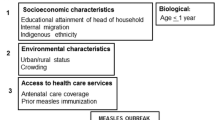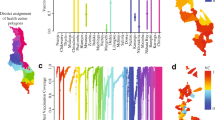Abstract
This study examines the impact of H. influenzae type b (Hib) conjugate vaccine on sociodemographic risk factors for invasive H. influenzae disease in the 2 years before and immediately after the introduction of Hib conjugate vaccine. An ecological study design was used and cases were identified using active surveillance employing several surveillance systems. The study population comprised all children aged <5 years resident in the West Midlands, an English health region, with laboratory confirmed invasive disease 2 years before (1990–1992) and 2 years after (1992–1994) the introduction of Hib conjugate vaccine. Selected sociodemographic variables derived from the UK census were obtained for all census enumeration districts in the region. Each variable was then ranked and divided into six categories. Linear associations between disease rates and sociodemographic variables were examined. Overall, there was a significant reduction in the incidence of invasive H. influenzae disease. In the pre-conjugate vaccine era there were trends of decreasing disease incidence with increasing child population density (p = 0.012) and total population density (p = 0.0023). In the post-conjugate vaccine period, total population density (p = 0.0275) remained significant and a trend of increasing disease incidence with increasing population mobility (p = 0.0012) was seen. Although Hib conjugate vaccine has resulted in a dramatic reduction in disease incidence changes in sociodemographic risk factors were identified in the post-conjugate vaccine period, particularly population mobility. Our results may have implications for current and future vaccine strategies.
Similar content being viewed by others
References
Stanwell-Smith RE, Stuart JM, Hughes AO, Robinson P, Griffin MB, Cartwright K. Smoking, the environment and meningococcal disease: A case-control study. Epidemiol Infect 1994; 112: 315–328.
Drucker E, Alcabes P, Bosworth W, Sckell B. Childhood tuberculosis in the Bronx, New York. Lancet 1994; 343: 1482–1485.
Patel P, Mendall MA, Khulusi S, Northfield TC, Strachan DP. Helicobacter pylori infection in childhood: Risk factors and effect on growth. Br Med J 1994; 309: 1119–1123.
Rees Jones I, Urwin G, Feldman RA, Banatvala N. Social deprivation and bacterial meningitis in North East Thames region: Three year study using small area statistics. Br Med J 1997; 314: 794–795.
Cochi SL, Fleming DW, Hightower AW, et al. Primary invasive Haemophilus influenzae type b disease: A population-based assessment of risk factors. J Pediatr 1986; 108: 887–896.
Fogarty J, Moloney AC, Newell JB. The epidemiology of Haemophilus influenzae type b disease in the Republic of Ireland. Epidemiol Infect 1995; 114: 451–463.
Takala AK, Clements DA. Socioeconomic risk factors for invasive Haemophilus influenzae type b disease. J Infect Dis 1992; 165(Suppl I): S11–S15.
Koopman JS, Longini IM Jr. The ecological effects of individual exposures and nonlinear disease dynamics in populations. Am J Public Health 1994; 84: 836–842.
Susser M. The logic in ecological: I. The logic of analysis. Am J Public Health 1994; 84: 825–829.
West Midlands Regional Health Authority. 1991 census local base statistics. West Midlands Regional Information Unit: Birmingham, 1992.
Olowokure B, Hawker J, Blair I, Spencer N. Decrease in effectiveness of routine surveillance of Haemophilus influenzae disease after introduction of conjugate vaccine: Comparison of routine reporting with active surveillance system. Br Med J 2000; 321: 731–732.
Floyd RF, Federspiel CF, Schnaffer W. Bacterial meningitis in urban and rural Tennessee. Am J Epidemiol 1974; 99: 395–407.
Rhodes CJ, Anderson RM. Persistence and dynamics in lattice models of epidemic spread. J Theor Biol 1996; 21: 125–133.
Pearson M, Makowiecka K, Gregg J, Woollard J, Rogers M, West C. Primary immunisations in Liverpool II: Is there a gap between consent and completion? Arch Dis Child 1993; 69: 115–119.
McIntyre PB, Leeder SR, Irwig LM. Invasive Haemophilus influenzae type b disease in Sydney children 1985-1987: A population-based study. Med J Aust 1991; 154: 832–837.
Sharland M, Atkinson P, Maguire H, et al. Lone parent families are an independent risk factor for lower childhood immunisation in London. CDR 1997; 7: R169–172.
Anderson RM, May RM. Directly transmitted infectious diseases: Control by vaccination. Science 1982; 215: 1053–1060.
Fraser DW, Darby CP, Koehler RE, et al. Risk factors in bacterial meningitis: Charleston County, South Carolina. J Infect Dis 1973; 127: 271–277.
Tarr PI, Peter G. Demographic factors in the epidemiology of Hemophilus influenzae meningitis in young children. J Pediatr 1978; 92: 884–888.
Gilbert GL, Clements DA, Broughton SJ. Haemophilus influenzae type b infections in Victoria, Australia, 1985-1987. Pediatr Infect Dis J 1990; 9: 252–257.
Redmond SR, Pichichero ME. Haemophilus influenzae type b disease: An epidemiologic study with special reference to day-care centers. JAMA 1984; 252: 2581–2584.
Takala AK, Eskola J, Leinonen M, et al. Reduction of oropharyngeal carriage of Haemophilus influenzae type b (Hib) in children immunized with an Hib conjugate vaccine. J Infect Dis 1991; 164: 982–986.
Barbour ML, Mayon-White RT, Coles C, Crook DWM, Moxon ER. The impact of conjugate vaccine on carriage of Haemophilus influenzae type b. J Infect Dis 1995; 171: 93–98.
Rathore MH, Dick M, Buckner P, Ayoub EA. Haemophilus influenzae type b invasive disease in urban and rural children: Immunization patterns and prevalence of disease. South Med J 1994; 87: 1083–1087.
Adegbola RA, Mulholland EK, Secka O, Jaffar S, Greenwood M. Vaccination with a Haemophilus influenzae type b conjugate vaccine reduces oropharyngeal carriage of H. influenzae type b among Gambian children. J Infect Dis 1998; 177: 1758–1761.
Li J, Taylor B. Childhood immunisation and family size. Health Trends 1993; 25: 16–19.
Reinert P, Liwartowski A, Dabernat H, et al. Epidemiology of Haemophilus influenzae type b disease in France. Vaccine 1993; 11(Suppl 1): S38–S42.
Quigley C, Kaczmarski EB, Jones DM, et al. Haemophilus influenzae type b disease in north-west England. J Infect 1993; 26: 215–220.
Greenland S, Morgenstern H. Ecological bias, confounding and effect modification. Int J Epidemiol 1989; 18: 269–274.
Reading RF, Openshaw S, Jarvis SN. Measuring child health inequalities using aggregations of enumeration districts. J Pub Health Med 1990; 12: 160–167.
Author information
Authors and Affiliations
Rights and permissions
About this article
Cite this article
Olowokure, B., Spencer, N.J., Hawker, J.I. et al. Invasive Haemophilus influenzae disease: An ecological study of sociodemographic risk factors before and after the introduction of Hib conjugate vaccine. Eur J Epidemiol 18, 363–367 (2003). https://doi.org/10.1023/A:1023606501705
Issue Date:
DOI: https://doi.org/10.1023/A:1023606501705




